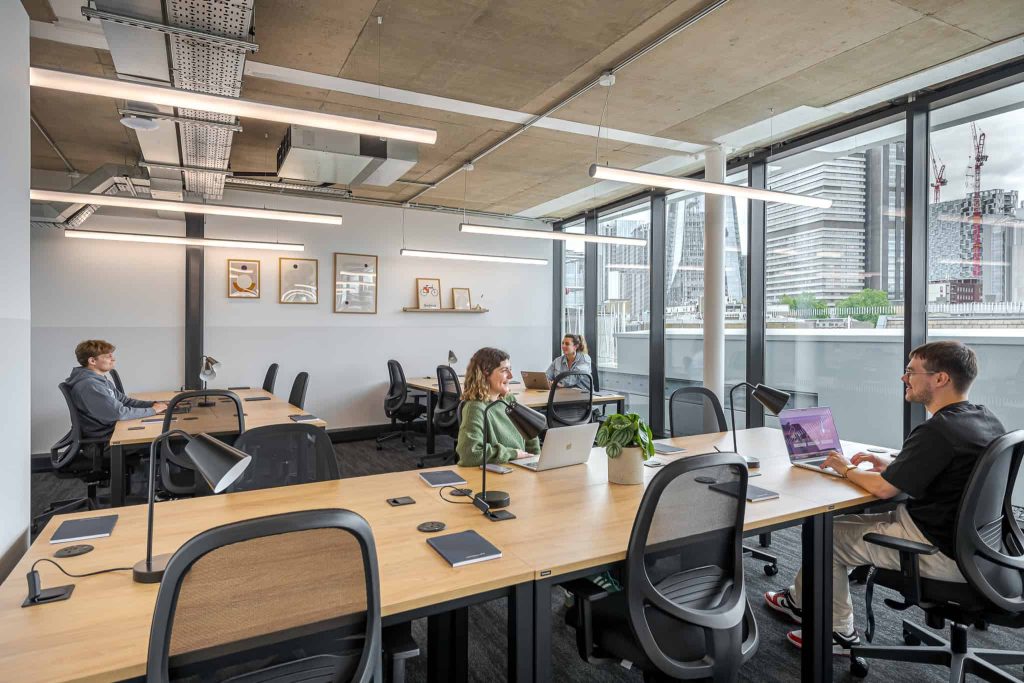How Reducing Clutter Can Increase Productivity at Work

Understanding the Impact of Clutter on Productivity
Clutter can be more than just an eyesore; it can significantly impede productivity in the workplace. A disorganized environment distracts employees, reducing their ability to focus and complete tasks efficiently. In fact, studies have shown that a cluttered workspace can decrease productivity by as much as 30%. This statistic highlights the urgency for businesses to consider the state of their work environments for the sake of overall efficiency.
Consider the following common signs of clutter in the workplace:
- A piles of paperwork overtaking your desk, making it difficult to locate vital documents and creating a sense of overwhelm.
- The inability to find essential items quickly, which can lead to wasted time and frustration during work hours.
- Increased stress levels among employees, as a chaotic environment can lead to heightened anxiety and distractions.
These symptoms contribute to a chaotic atmosphere that stifles creativity and motivation. In a corporate setting, where teamwork is essential for success, the detrimental effects of clutter can be even more pronounced. For instance, a team struggling to find shared resources may experience delays in project timelines, ultimately affecting client satisfaction and profitability.
Reducing clutter can lead to numerous benefits, including:
- Improved focus and concentration. A clean and organized workspace allows employees to direct their attention where it is most needed, enhancing their problem-solving abilities and enabling them to process information more effectively.
- Enhanced teamwork and collaboration. A tidy environment fosters better communication among team members. When resources are readily available and easily accessible, collaboration becomes smoother and more efficient.
- Greater employee satisfaction and morale. Employees often feel more valued and motivated in an organized workspace, contributing to a culture of pride and ownership in their roles.
Strategies for reducing clutter may include implementing digital solutions to organize paperwork, encouraging regular clean-up days within teams, and providing organizational tools, such as filing cabinets or cloud storage systems. Additionally, adopting a “one in, one out” policy can prevent the accumulation of unnecessary items, keeping the workspace pristine.

In this article, we will explore various strategies to effectively reduce clutter and the profound effects this can have on overall workplace productivity. Are you ready to unlock the full potential of your work environment by embracing a more organized approach? It’s time to dive deeper into how a slight change in organization can lead to remarkable improvements in efficiency and morale.
DISCOVER MORE: Click here to learn practical strategies
The Psychological Benefits of an Organized Workspace
Reducing clutter in the workplace is not just a matter of aesthetics; it has profound psychological implications that can drive productivity. When employees are surrounded by a neat and orderly environment, the psychological benefits can manifest in various ways, ultimately enhancing performance. One of the most significant aspects is the impact of visual clarity on mental clarity. A clean workspace allows the mind to process information more efficiently, cutting down on cognitive overload. Without the distractions that clutter creates, employees can harness their cognitive resources to focus on what truly matters—meeting deadlines, brainstorming ideas, and achieving goals.
In fact, a study conducted by the Princeton University Neuroscience Institute found that physical clutter can make it difficult for the brain to focus and process information. Participants in the study exhibited increased activity in the brain’s frontal cortex—a region associated with higher-level functions such as decision-making and problem-solving—when working in a tidy space. This underscores the importance of maintaining an organized environment for fostering critical thinking and creativity.
Another key benefit of decluttering is a noticeable reduction in stress levels. According to a report by the American Psychological Association, individuals who feel overwhelmed by clutter often experience heightened anxiety and stress, which can lead to burnout. In a high-pressure corporate environment, where timely execution is everything, maintaining a stress-free atmosphere can work wonders for employee morale. A simple cleanup can lead to a more harmonious workplace where employees feel more in control and less anxious.
Practical Tips for Decluttering Your Workspace
Implementing effective decluttering strategies can lead to immediate improvements in both individual and team productivity. Here are some practical tips to consider:
- Digitize documents: Transitioning to a paperless environment can drastically reduce physical clutter. By storing important files on cloud services, employees can access documents with just a few clicks, eliminating the need for bulky filing cabinets.
- Create designated spaces: Assign specific locations for frequently used items. This prevents the misplacement of important tools and fosters a culture of organization among team members.
- Implement “clean desk” policies: Encourage employees to leave their desks clear at the end of the workday. This fosters a routine of tidiness and ensures that employees come back to a fresh start each day.
- Establish a regular decluttering schedule: Monthly or quarterly clean-up days can help keep clutter in check and encourage team participation and bonding during the process.
By adopting these strategies, organizations can create a more streamlined environment that not only supports productivity but also enhances overall employee satisfaction. In the quest for increased efficiency, the decision to tackle clutter is a simple yet impactful step that can yield lasting benefits.
Understanding the Impact of Clutter on Productivity
Clutter can significantly impact our ability to focus and work efficiently. It creates a chaotic environment that can lead to distractions, stress, and a decline in overall job performance. To truly grasp how reducing clutter enhances productivity, it is essential to analyze two main categories of advantage: mental clarity and efficient time management.
| Mental Clarity | Efficient Time Management |
|---|---|
| Enhanced Focus | Streamlined Workflow |
| Eliminating clutter fosters a clearer mind, enabling employees to concentrate better on their tasks. | A decluttered workspace promotes efficient processes, allowing quicker access to necessary materials and reducing wasted time. |
| Reduced Stress | Less Time Searching |
| Minimizing clutter can lead to lower levels of anxiety and a more positive work atmosphere. | With everything in its place, employees spend less time searching for documents or tools they need. |
Cultivating an organized workspace not only benefits individual employees but can also reflect positively on team dynamics, enhancing collaboration and communication among coworkers. The more streamlined an environment is, the more likely teams can achieve their goals effectively. Exploring additional techniques for decluttering can be the next step in the journey towards fostering a productive workplace.
EXPLORE MORE: Click here to discover how minimalism can enhance your mental well-being
The Impact of Clutter on Team Dynamics
Beyond individual productivity, clutter can significantly influence team dynamics and collaboration within a workplace. When employees work in cluttered environments, communication can be hampered, leading to misunderstandings and inefficiencies. A disorganized workspace may convey a sense of chaos, discouraging employees from seeking assistance or collaborating effectively. In contrast, a clean and ordered environment sends a positive message about the importance of teamwork and clarity, encouraging open dialogue among team members.
Research indicates that employees are more likely to collaborate in spaces that promote organization. A study by the University of California found that when employees shared tidy work areas, they were 25% more cooperative in completing tasks. This finding emphasizes that fostering a culture of cleanliness not only boosts individual productivity but can also enhance collective outcomes. In collaborative settings, encouraging team members to declutter their respective areas becomes increasingly paramount, creating a sense of shared responsibility to help maintain an organized and effective workspace.
Technology’s Role in Decluttering
The advent of modern technology plays a critical role in decluttering and promoting productivity. Many organizations are now employing tools that help streamline tasks and reduce physical clutter. For instance, project management applications such as Trello and Asana enable teams to visualize their workload without needing to rely on paper notes or endless email chains. Such tools allow for better organization of tasks, ensuring that team objectives are clear, thus mitigating the distractions that clutter can introduce.
Moreover, companies are increasingly adopting smart office solutions, which utilize the Internet of Things (IoT) to create a seamless working environment. Smart devices can monitor and adjust workspace conditions based on employees’ needs, contributing to both comfort and order. These devices foster an uncluttered workspace by automatically organizing task priorities and keeping the digital landscape tidy. As employers invest in technology that reduces physical and digital clutter, they create a more efficient atmosphere that naturally drives productivity.
The Role of Leadership in Promoting Clutter-Free Environments
Leadership plays a crucial role in instilling a culture of organization and cleanliness. When leaders prioritize maintaining organized spaces, they set a precedent that encourages employees to follow suit. Initiatives such as hosting workshops on workspace organization or providing resources for employees struggling with clutter can empower team members to take ownership of their areas. Recognizing and rewarding employees who embrace and promote a clutter-free environment can also create a positive feedback loop, helping sustain higher productivity levels across the board.
The influence of a clutter-free workspace reaches far beyond immediate task completion; it extends to overall employee well-being and satisfaction. According to a survey by the Furniture Company, 70% of employees felt that a tidy workspace increased their overall job happiness. With such persuasive statistics, it stands to reason that fostering a culture of organization is not just beneficial for output—it’s imperative for cultivating a productive and engaged workforce.
In summary, addressing the issue of clutter in the workplace must be a collective effort supported by both employees and leadership, creating an environment conducive to productivity, collaboration, and overall workplace satisfaction.
DISCOVER MORE: Click here for space-saving tips
Conclusion
In conclusion, the relationship between reducing clutter and enhancing productivity is increasingly recognized as a vital component of modern work environments. From individual focused tasks to team collaborations, a tidy workspace creates an atmosphere that fosters efficiency, creativity, and cooperation. Studies consistently show that employees thrive in organized settings, resulting in a marked increase in morale and job satisfaction.
Moreover, the integration of technology in a clutter-free workspace offers innovative solutions that streamline processes and maintain order. Tools like project management software and smart office devices not only help mitigate physical clutter but also enhance digital organization, allowing teams to focus on what truly matters: their work. It’s a transformation that underscores the importance of innovation and adaptability in today’s fast-paced work culture.
Ultimately, strong leadership is essential in nurturing a culture of cleanliness and organization. By prioritizing clutter reduction, employers can empower their teams, promote well-being, and instill a shared responsibility for maintaining an orderly workspace. As businesses continue to evolve, embracing a clutter-free philosophy will not only lead to higher productivity levels but also contribute to a satisfying and engaged workforce.
As organizations strive for excellence, addressing workspace clutter should not be seen merely as an organizational task but as a strategic initiative with far-reaching implications for success. Exploring methods to create a clean work environment is vital for fostering a culture of efficiency and collaboration—key ingredients for achieving long-term business objectives.
Related posts:
The Influence of Clutter Reduction on Sustainability and Conscious Consumption
The Relationship between Decluttering and Mental Health
Practical Strategies to Reduce Clutter in Remote Work Environments
Common Challenges in Decluttering and How to Overcome Them
The Importance of a Minimalist Mindset in Reducing Clutter
The Connection between Clutter Reduction and Mindfulness Practice in Daily Life

Linda Carter is a writer and organization expert specializing in minimalism and personal organization. With extensive experience helping individuals create clutter-free, functional spaces and adopt mindful habits, Linda shares her knowledge on our platform. Her goal is to empower readers with practical advice and strategies to simplify their lives, stay organized, and achieve a sense of calm and balance in their daily routines.